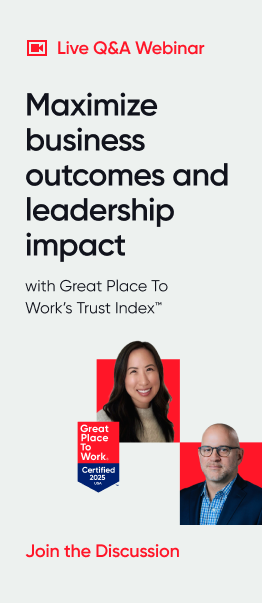DEIB, Diversity & Inclusion, Employee Experience, Recruiting, Talent Acquisition, Talent Management
It’s time to update your thinking on hiring and engaging people with disabilities. Being intentional about how you engage employees with disabilities is not only ethical, it’s also a talent acquisition strategy that can benefit your company long-term.
The population of people with disabilities is an untapped talent market. This group is made up of many incredible individuals with invaluable skills and knowledge. However, many companies struggle to ensure that their workplace includes employees with disabilities.
A Center for Talent Innovation study found that only 39% of disabled employees disclose their disability status to their managers. Of those employees who are open about their disability status, 65% state they regularly feel happy or content at work — versus only 27% of those who don't discuss their status.
At Great Place To Work®, our research tells us that employees who feel like they can bring their whole selves to work, and disclose their support needs without hesitation, are exponentially more likely to give their best every day.
In other words, psychological safety leads to engaged and thriving employees. On the Great Place To Work Trust Index™ Survey, and in U.S. workplaces in general, disclosing a disability is not required. Our research on the link between business resilience and diversity, equity, inclusion, and belonging (DEIB) has shown that for every 10% of employees that chose not to respond on the survey, there was a 6-point decrease in a company’s overall levels of trust, pride, and camaraderie.
Hiding one’s identity in a survey can signify that a workplace culture suffers from favoritism, toxic work relationships, and microaggressions.
Psychological safety helps team members feel comfortable sharing opposing ideas or presenting new ones. But central to psychological safety is the willingness to be vulnerable in front of others.
In our research, employees who believe their managers “care about them as a person” are 36% more likely to bring innovative ideas to your workplace.
The payoff is clear: Supporting employees with a disability will help your business thrive. Mental health resources, ergonomic equipment, robust short- and long-term disability, and paid medical leave are all benefits that support and retain people with disabilities.
The flexibility of remote work compared to in-person work can be especially valuable when hiring employees with disabilities.
What is considered a disability in the workplace?
When we think of a disability, we often think of something we can easily see, such as having difficulty walking or using a wheelchair. Those “visible disabilities” are usually prioritized in professional and public settings over other disabilities.
In recent years, more research has been emphasizing “invisible disabilities.” These are disabilities that can’t be easily identified by looking at someone. Examples can include neurodivergence, PTSD, and cancer.
Under the Americans with Disabilities Act (ADA), a disability is a physical or mental impairment that limits at least one major life activity. A major life activity may be a basic task such as standing, walking, sleeping, lifting, reading, or working a major bodily function like the digestive, circulatory, or respiratory systems.
On the Great Place To Work Trust Index™ Survey, employees are considered to have a disability if they have a physical or mental impairment or medical condition that substantially limits a major life activity, or if they have a history or record of such an impairment or medical condition.
Some disabilities covered under the ADA may not immediately come to mind. For example, major depressive disorder, diabetes, post-traumatic stress disorder, learning disabilities, anxiety, migraine headaches, and gastrointestinal disorders.
One out of four adults in the United States have a disability. In 2021, an additional 1.2 million people over the age of 16 were identified as having a disability compared to 2020.
These numbers are steadily rising due to COVID-19. We are still learning the full implications of long COVID, which some specialists believe will significantly impact the number of people with disabilities worldwide. Only 19.1% of people with a disability were employed in 2021, versus 63.7% without a disability, demonstrating the overall lack of effort towards including this population of employees.
How businesses benefit by hiring people with disabilities
Recruiting and hiring people with disabilities isn’t just the morally and ethically right thing to do. It can also influence business outcomes such as innovation, inclusivity, customer growth, and profitability.
1. Spur innovation
Hiring people with disabilities can expand your opportunities for innovation. That’s because people with disabilities tend to be excellent problem solvers — many have ample experience thinking of creative solutions to problems as they navigate a world that is often not built for them. They can have a unique perspective on challenges and are often persistent when encountering a roadblock.
KPMG, Great Place To Work Certified™ company on the Fortune 100 Best Company to Work For® List recognizes the value of hiring people with disabilities and has prioritized recruiting and increasing its support for people with visible and invisible disabilities. It has developed an accessibility strategy and launched Neurodiversity@Work to help unleash the potential of neurodiverse talent at KPMG and for its clients.
The program has helped KPMG establish a university council with 12 schools, engage more than 45 volunteers, enter two formal partnerships, create six job openings, and initiate nearly two dozen internal and external marketing initiatives.
2. Improve bottom-line performance
Hiring people with disabilities also has proven financial benefits. A 2018 Accenture study found that companies that were inclusive towards people with disabilities had 28% higher revenue on average over a four year period compared to their less-inclusive counterparts.
Employers who create a culture of accommodation and accessibility for employees with disabilities lower barriers to performance.
Think about it: When an employee living with chronic migraines doesn't have the workplace flexibility to visit a doctor or fit work around their migraine, it adds up to countless hours of lost production, thought, innovation, and advancement.
3. Understand and target your customers more accurately
People with disabilities make up a sizable portion of the consumer marketplace. Having more employees with disabilities can help ensure that products are being designed with this population in mind to reach more customers.
4. Promote an environment of inclusion and understanding
Hiring people with disabilities fosters an inclusive work environment. Diverse teams create bigger and more frequent opportunities for cultural exchange. Team members can witness the experiences of employees with disabilities, building greater empathy and awareness across people from diverse backgrounds.
Hiring (and keeping) people with disabilities – 6 tips for a successful employee life cycle
Here are six ways to make your organization more appealing to current and potential employees with disabilities.
1. Detail accessibility in job postings
List any potential accessibility concerns when advertising a job and prepare recruiters to answer applicants' questions. This includes elevator access, stairs, curbs, and width of passageways. Less obvious factors, such as harsh fluorescent lighting, loud noises, accessible desks, and lack of cell service or internet, could be deciding factors for an applicant.
Taking the time to outline these details in your job posting sends a strong message to people with disabilities that their needs are considered and cared for.
2. Train managers on the accommodation process
Managers are often the first people an employee with a disability will go to for guidance with accommodations during the hiring process or on the job. Ensuring that managers have a working knowledge of the accommodation process and can support their employees while they work (including opportunities to be social, network, and celebrate as a team) is vital, especially since there is often a stigma around having a disability.
100 Best Companies like Experian realize the importance of inclusive training. Experian employees now have access to a “Disability Fundamentals for Managers” course through Disability:IN — a 30-minute interactive training that helps managers learn about disability awareness, etiquette, disclosures, and accommodations, as well as how to hold accessible meetings and events.
Giving all employees, especially managers, a high-level overview of what it means to be an employee with disabilities helps build empathy and develop inclusive leadership skills.
3. Focus on inclusive benefits
For many employees with a disability, benefits can be a deciding factor in choosing a job. If someone has regular doctors’ visits or expensive medications, they may not be able to wait 60 or 90 days for their health insurance to kick in.
In addition, make sure that your healthcare plans have adequate coverage and listen to feedback from employees with disabilities about what other benefits they need. Mental health resources, ergonomic equipment, robust short- and long-term disability, and paid medical leave are all benefits that support people with disabilities.
4. Fit disabilities into the larger DEIB and values discussion
When it comes to DEIB, disabilities are often left out of the conversation. Educating employees about the experiences of people with disabilities and normalizing the concept of accommodations can help remove the stigma and ensure an accessible work environment.
Certified workplace Rocket Companies developed the “empathy generator,” a tool that helps employees create products that are accessible to people with disabilities. It simulates the experience of having the disabilities that team members such as coders, designers, and researchers are trying to accommodate.
Most people who do not live with disabilities may find it difficult to fully conceptualize the barriers that people with disabilities face daily, so these kinds of tools and exercises can help increase awareness.
The population of people with disabilities in the United States also highlights the importance of intersectionality. According to the U.S. Bureau of Labor Statistics, Black and Hispanic people with disabilities are more likely than their white counterparts to be without a job.
5. Allow flexible schedules and remote work
The flexibility of remote work compared to in-person work can be especially valuable for employees with disabilities. For example, if someone has chronic pain and cannot drive an hour to get to the office, they cannot accept a job. If they can work remotely, they are better able to manage their pain and work in a safe environment.
6. Ensure that training and development opportunities are inclusive
Present information through different modalities, including visual, written, and auditory. For audio or video components, ensure that captions and transcripts are available and work with screen readers.
Wise organizations are catching on to the value of hiring and engaging people with disabilities. Research by the Economics Innovation Group found that people with a disability aged 25 to 54 were 3.5% more likely to be employed in the second quarter of 2022 than pre-pandemic. How is your organization adapting and making your workplace more attractive to employees with disabilities?
Want to know exactly how you can support your employees?
Being intentional about your DEIB initiatives starts with understanding your workforce in detail. Great Place To Work Certification™ helps you measure and track your employee experience with our research-backed Trust Index Survey. Ask us today about how to get started on your Certification and access the workforce data you need to improve your workplace for diverse groups, including those living with a disability.











